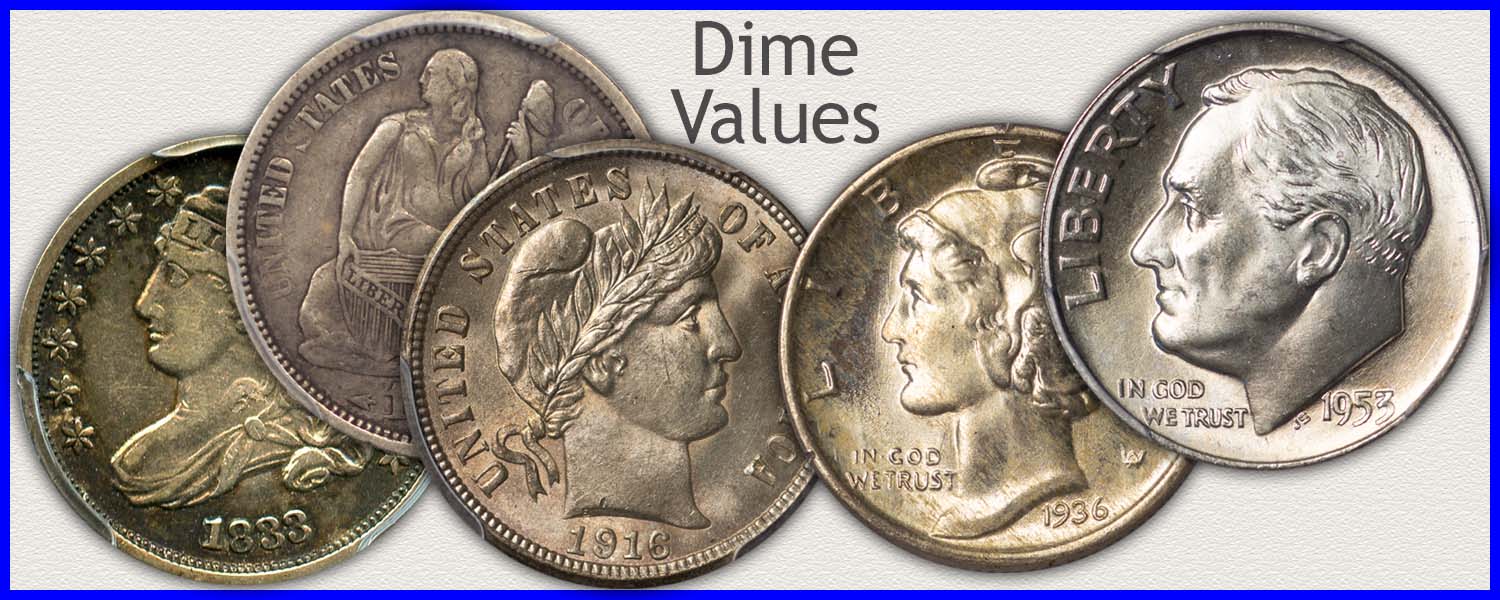Coin Values Moving with Precious Metals: Up-Dated 4/7/2025: Gold $3035 | Silver $30.08
Seated Dimes Value and Key Points to Identify
Seated dimes value is found by correctly identifying date, mint that struck the coin, and its state of preservation. Also, subtle design changes throughout the life of the series are identified. A step by step process picks up all the key elements, helping determine how much these old dimes are worth.
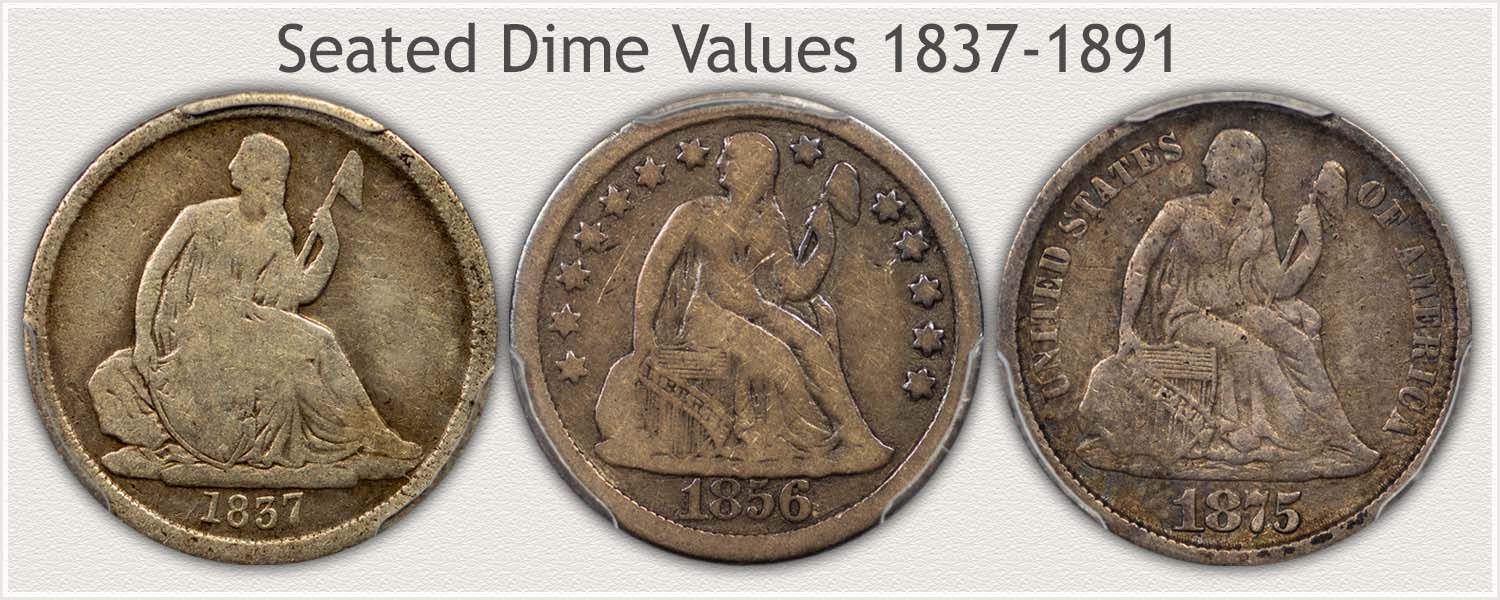
Steps Leading to Value:
- Step 1: Date, Mintmark and Variety - A wide range of variables are identified to correctly place a value on Seated Dimes
- Step 2: Grading Condition - The amount of wear to the surface is judged using images to compare.
- Step 3: Special Qualities - Subtle design modifications over the years introduced sub-types to recognize and value.
The step by step process is detailed below the chart.
| Seated Dimes Value 1837 to 1891 | ||||
|---|---|---|---|---|
| Condition of Coin | ||||
| Date | Good | Fine | Extremely Fine | Mint State |
| Seated Dimes Value Updated | 2025 | |||
| No Stars Obverse Type 1837-1838 | ||||
| $54 | $98 | $263 | $1,838 | |
| Stars Obverse Type 1838-1860 | ||||
| $18 | $34 | $172 | $264 | |
| Legend Obverse Type 1860-1891 | ||||
| $17 | $23 | $44 | $130 | |
| The Following are a Few Selected Dates | ||||
| 1837 | $54 | $98 | $263 | $919 |
| 1841 | $16 | $34 | $82 | $267 |
| 1842 | $20 | $34 | $103 | $264 |
| 1843 | $18 | $33 | $77 | $366 |
| 1845 | $19 | $38 | $78 | $275 |
| 1850 | $18 | $38 | $99 | $237 |
| 1851 | $18 | $34 | $78 | $325 |
| 1852 | $18 | $34 | $82 | $345 |
| 1853-A | $18 | $30 | $64 | $242 |
| 1856 SD | $18 | $34 | $70 | $280 |
| 1856 O | $20 | $58 | $114 | $614 |
| 1857 | $18 | $35 | $83 | $210 |
| 1857 O | $16 | $30 | $87 | $319 |
| 1858 | $18 | $33 | $79 | $219 |
| 1876 | $17 | $23 | $46 | $134 |
| 1876 S | $17 | $27 | $69 | $136 |
| 1877 | $17 | $26 | $53 | $122 |
| 1882 | $17 | $23 | $47 | $120 |
| 1883 | $17 | $21 | $36 | $142 |
| 1884 | $17 | $23 | $49 | $120 |
| 1885 | $16 | $23 | $45 | $120 |
| 1886 | $16 | $22 | $44 | $169 |
| 1887 | $17 | $23 | $36 | $117 |
| 1887 S | $17 | $23 | $36 | $145 |
| 1888 | $17 | $20 | $44 | $143 |
| 1888 S | $17 | $24 | $41 | $265 |
| 1889 | $17 | $22 | $39 | $115 |
| 1890 | $17 | $23 | $41 | $101 |
| 1891 | $17 | $23 | $47 | $153 |
| 1891 O | $19 | $23 | $52 | $151 |
| 1891 S | $18 | $24 | $43 | $139 |
The above are wholesale coin values. Computed from dealer's price lists with various mark-up factors figured in. They reflect closely the value you would expect to receive when selling. Variations in value do occur subject to subtle grading points, collector demands and dealer needs.
The chart covers many of the Seated Dimes encountered, including a few rare dates, mints and varieties. Others are seldom found because of low survivor numbers. For additional reference... CDN publishes a price guide, covering the retail Bust Dime Value in detail.
Step 1: | Date Plus Variety and Mintmark are Identified
Three major varieties are important to Seated Dimes and their value. As the series continued over the years small adjustments were made to the designs on both the obverse and reverse. Each change representing distinct varieties.
No Stars Obverse Type: Seated Dime: 1837 to 1838
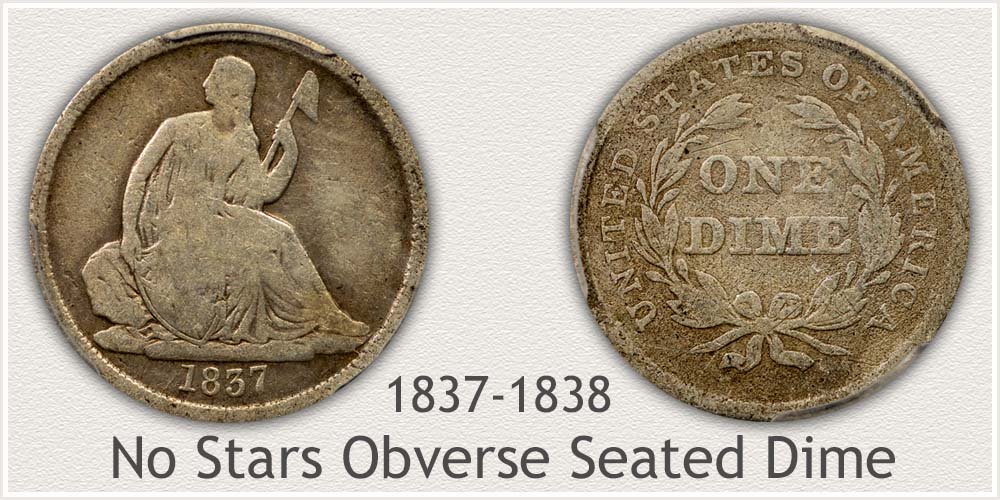
The beginnings of the Seated Dime series feature a full figure of Liberty seated holding the US shield. Shield representing the Congress and pole with a Liberty cap on top symbolizing Freedom complete the major devices. A reverse with olive wreath surrounding ONE | DIME finished with the legend along rim defining the coin from prior years.
A design lasting only a short time, the No Stars variety is a highly sought coin. Low in original mintage numbers and scarce in numbers today keep values solid.
Mints of the No Stars Obverse Type Seated Dime
New Orleans Mint
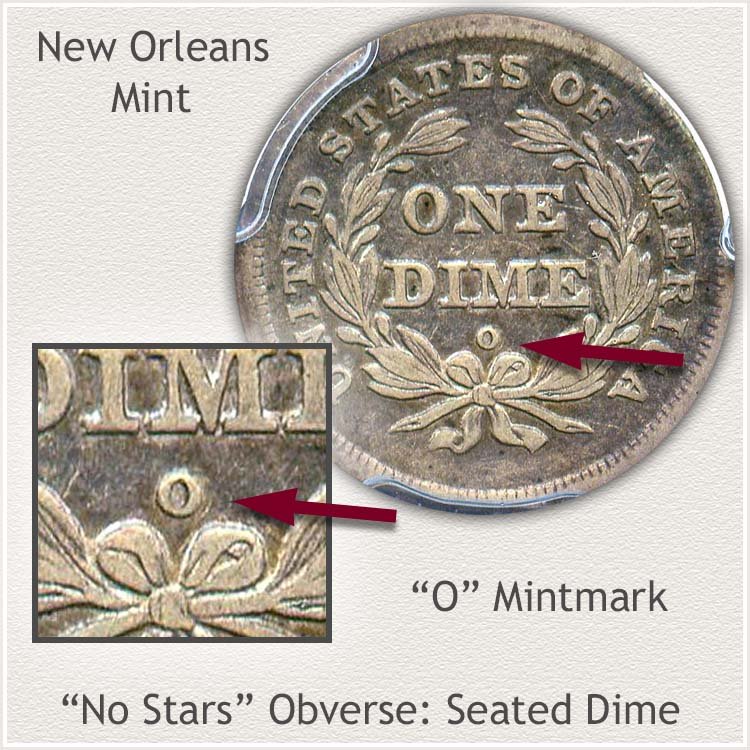
In 1838 only, New Orleans mint struck less than half a million of the No Stars Dime variety. A unique situation and a one year only type. New Orleans opened in 1838 and these dimes are the first from the brand-new mint. All are worth a premium. Mintmark "O" is located on the reverse within the wreath.
Philadelphia Mint
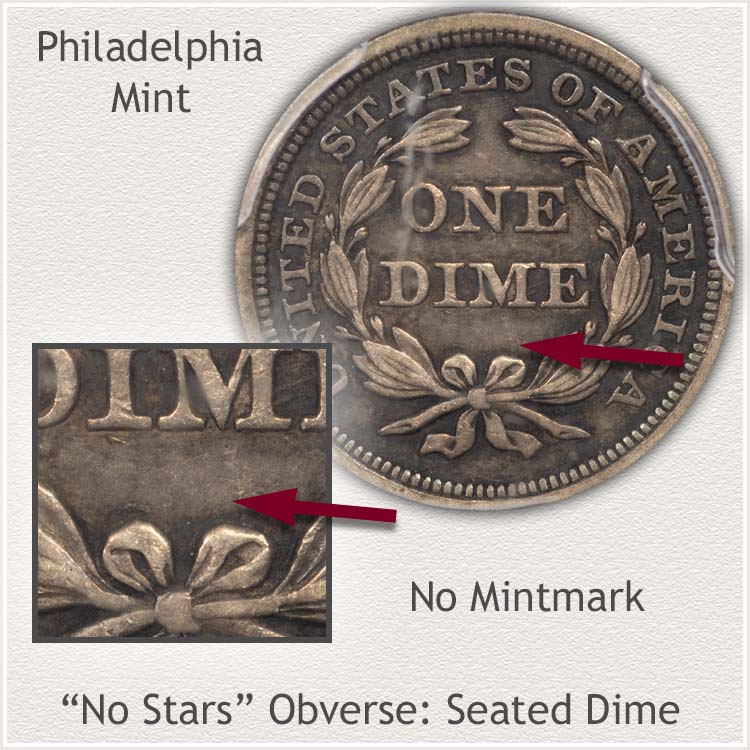
Philadelphia began the minting of the new Seated Dime design in 1837, striking close to 700,000 pieces. The mint did not use a mintmark at the time, all 1837 dimes without a mintmark are from the Philadelphia mint.
Stars Obverse Type: Seated Dime: 1838 to 1860
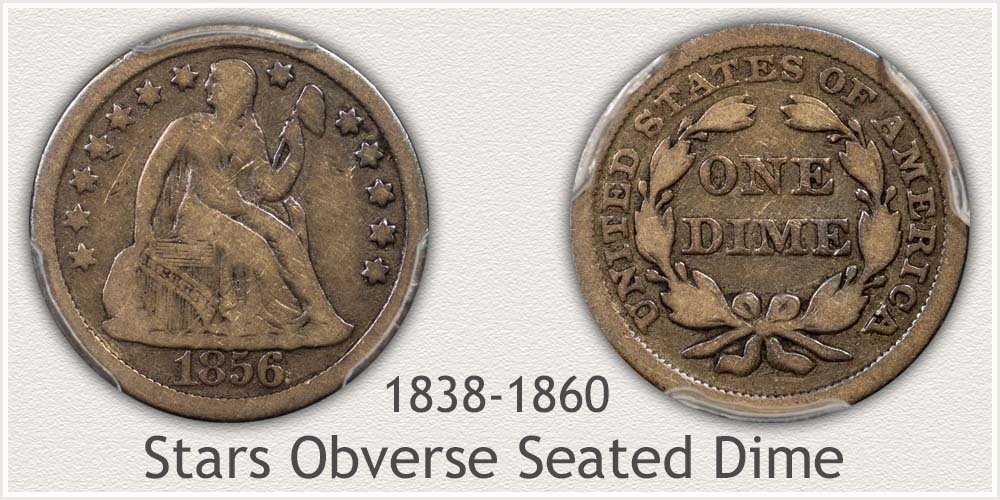
Second design of the series and the main feature of Liberty remains the same. Lending to the name of the type are the thirteen stars added to the field along the rim. The stars are arranged six stars - right and seven stars - left, a similar pattern to the earlier Bust series.
Three mints worked striking the Stars Obverse Type; supplying dimes for the economy. Combined mintage of the mints placed just over 64 million dimes into circulation. Identity of the mints is important as they are valued separately on the chart. Branch mints used mintmarks to indicate their production.
Mints of the Stars Obverse Type Seated Dime
New Orleans Mint
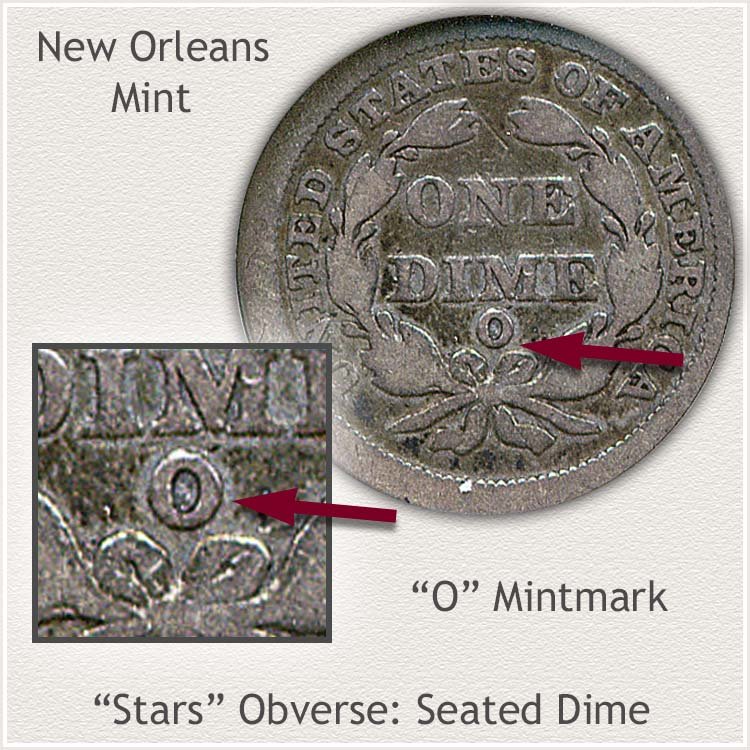
New Orleans mint contributed to the Stars Obverse Type with just under 15 million dimes. They identified their production with a large "O" mintmark within the wreath just under "Dime" of the denomination.
San Francisco Mint
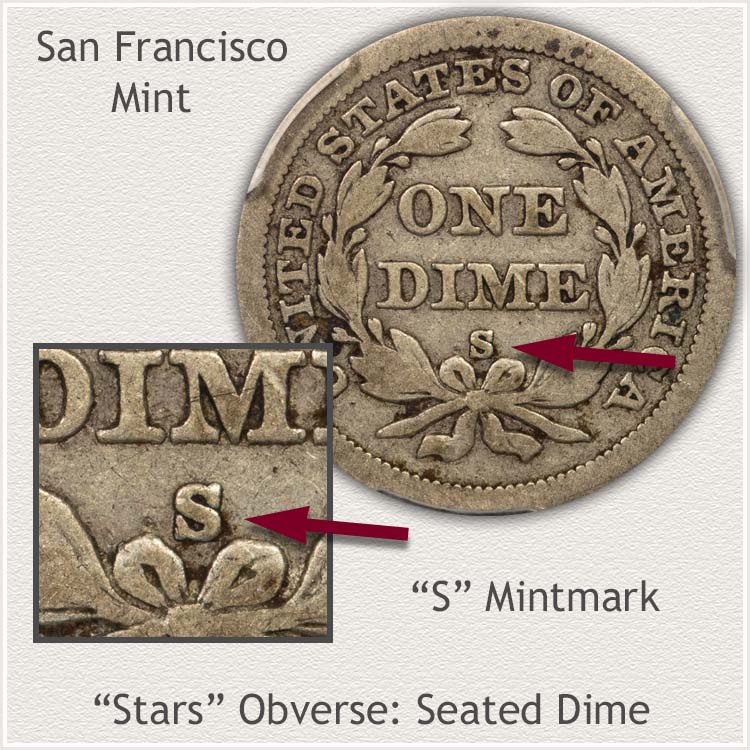
San Francisco was a new mint in 1854 and started minting dimes in 1856. By the time the Stars Obverse type was ended, the mint struck only 330,000 dimes. Representing the lowest number as a variety these are sought by collectors. Mintmark "S" is within the wreath.
Philadelphia Mint
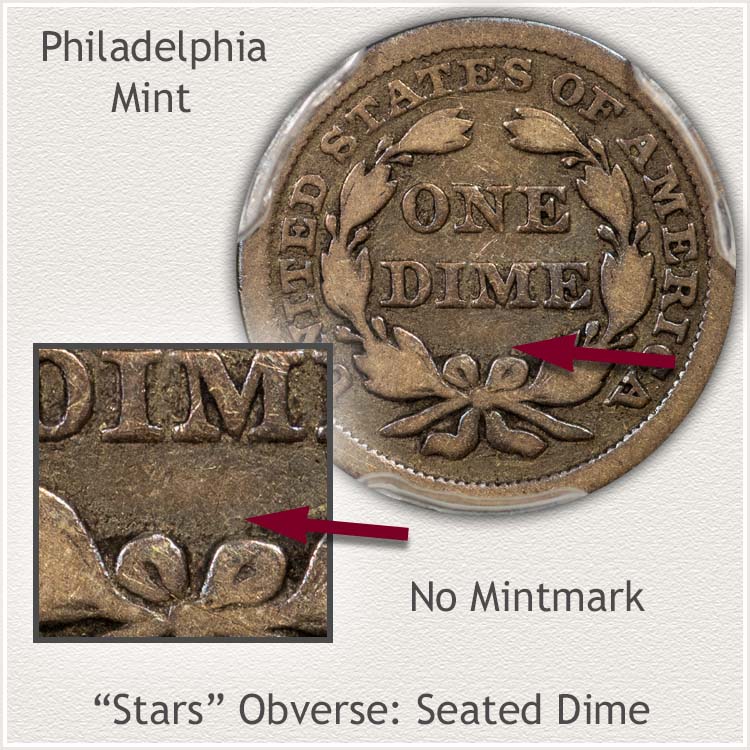
Just under 50 million dimes were struck by the Philadelphia mint. The main mint contributed by far the largest number of Stars Obverse Seated dimes. Many are available to collectors and values are affordable to collect in circulated grades.
Philadelphia did not use a mintmark to identify production. Dimes without a mintmark were struck at Philadelphia.
Legend Obverse Type: Seated Dime: 1860 to 1891
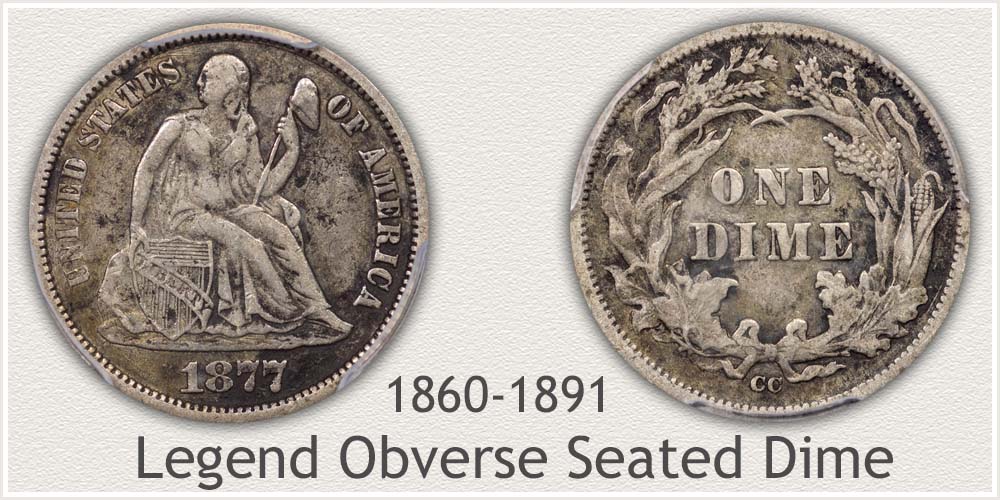
The longest running design variety of the Seated dime series they are the type likely encountered. Values are similar as earlier types with a few scarce and rare dates within the type.
Biggest change to the obverse is replacing the stars with the legend from the reverse. Liberty remains unchanged. On the reverse a wreath of oak and corn now fills the area to the rim. One Dime is within the wreath.
Mints of the Legend Obverse Type Seated Dime
New Orleans Mint
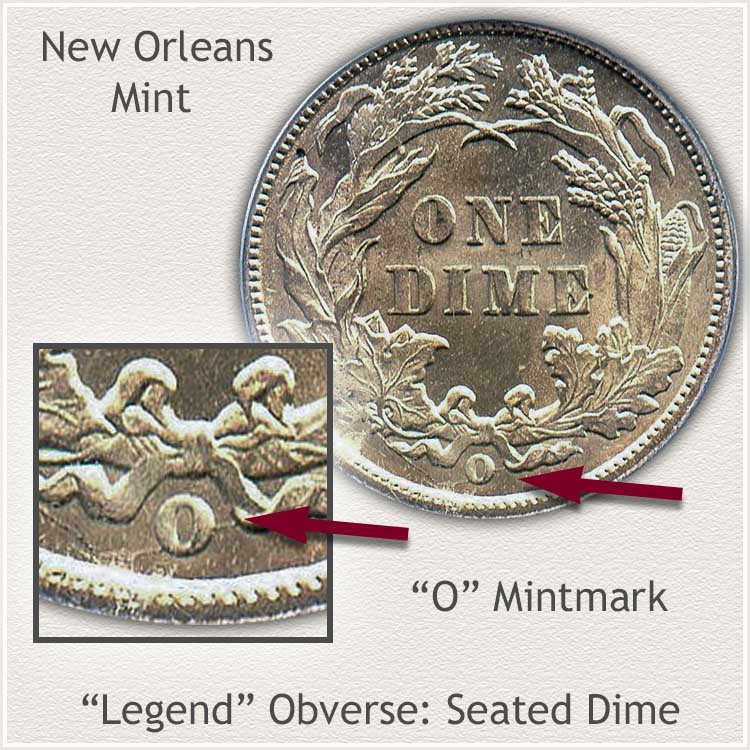
New Orleans struck a few 1860 dimes and just over 4.5 million 1891 dimes. A limited amount of production, placing these as the fewest of the mintmark variety. Just under the wreath is an "O" mintmark to identify the mint.
San Francisco Mint
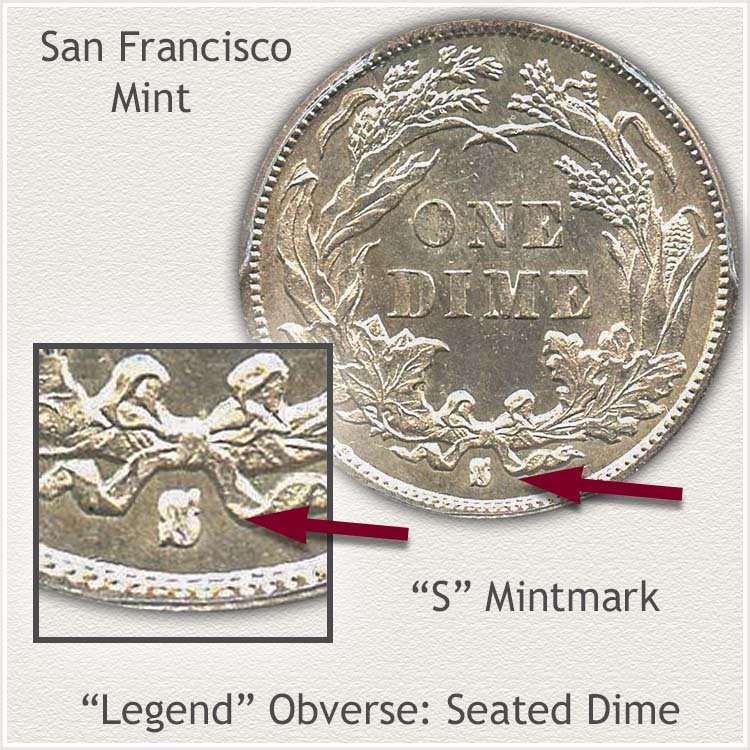
San Francisco continued striking dimes and added 37 million of the Legend Obverse type over the years. Notable is 1885 a scarce low production year. An "S" mintmark under the bow of the wreath identifies the San Francisco mint.
Carson City Mint
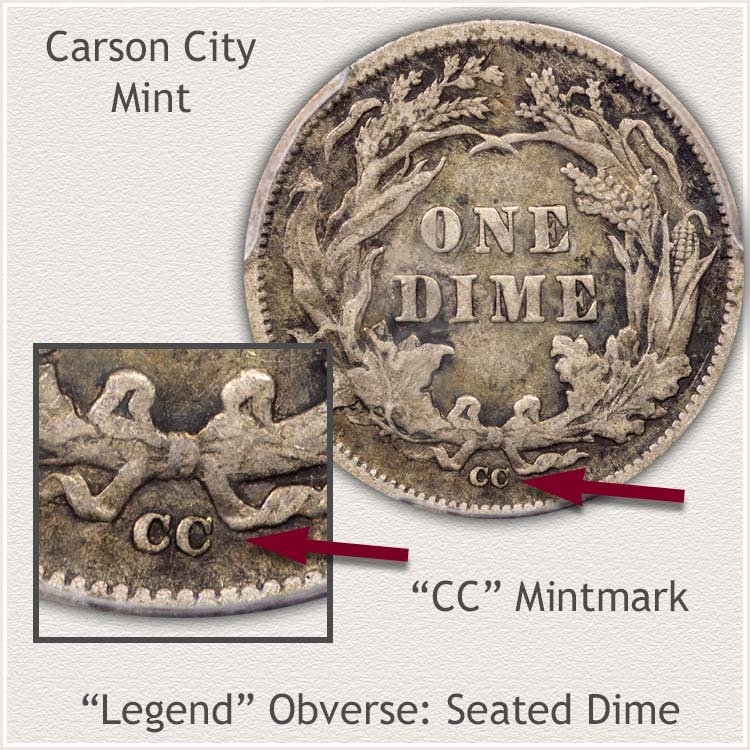
A popular favorite with collectors, all Carson City dimes are sought. Carson City struck dimes from 1871 to 1878 a short time with moderate numbers. Find the "CC" mintmark under the wreath.
Philadelphia Mint
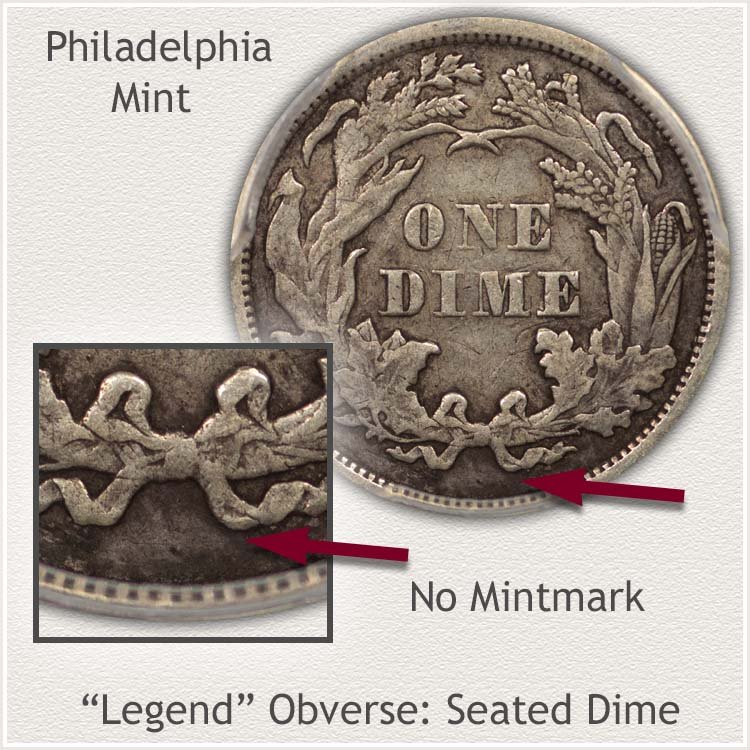
Philadelphia continued placing the majority of dimes into circulation. Almost 119 million Legend Obverse dimes were struck by Philadelphia. Ample production most years. Interestingly, Philadelphia is noted as having the lowest variety of the entire series, 1867 just over 6 and one half thousand. A very scarce dime.
Seated dimes without a mintmark confirms a Philadelphia struck dime.
Step 2: | Condition is Judged and Grade Determined
Often Seated Dimes value increases dramatically when found in very nice condition. True, dealers and collectors are all searching for rare dates but they also keep an eye on the condition. You stand a better chance of finding a high "Grade" coin than a rare date.
Compare your coins to the grading images below and find the closest match. Focus your attention on the shield. The word LIBERTY with all the letters visible, places the coin in "Fine" or better condition. Less than the entire letters in LIBERTY showing and your dime drops into "Good" condition and a lower value.
Grading Condition of Stars Obverse Variety Seated Dime
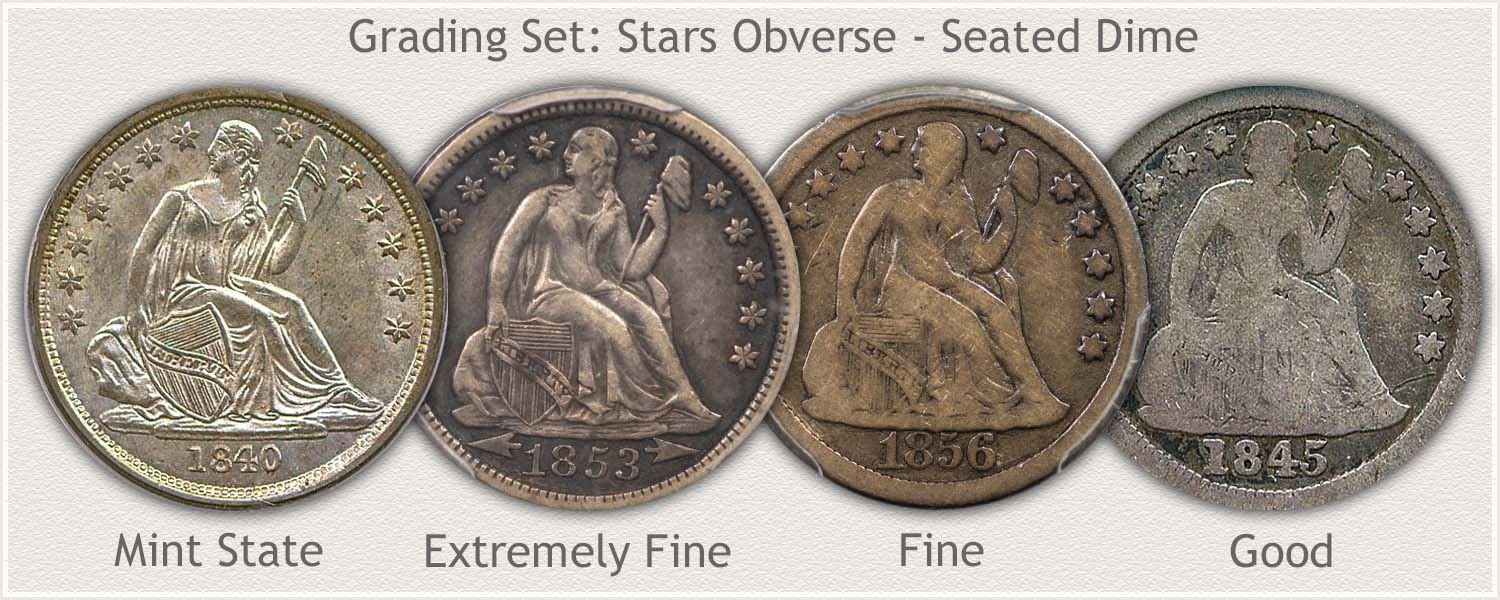
Mint State Grade: "Stars Obverse" Seated Dime
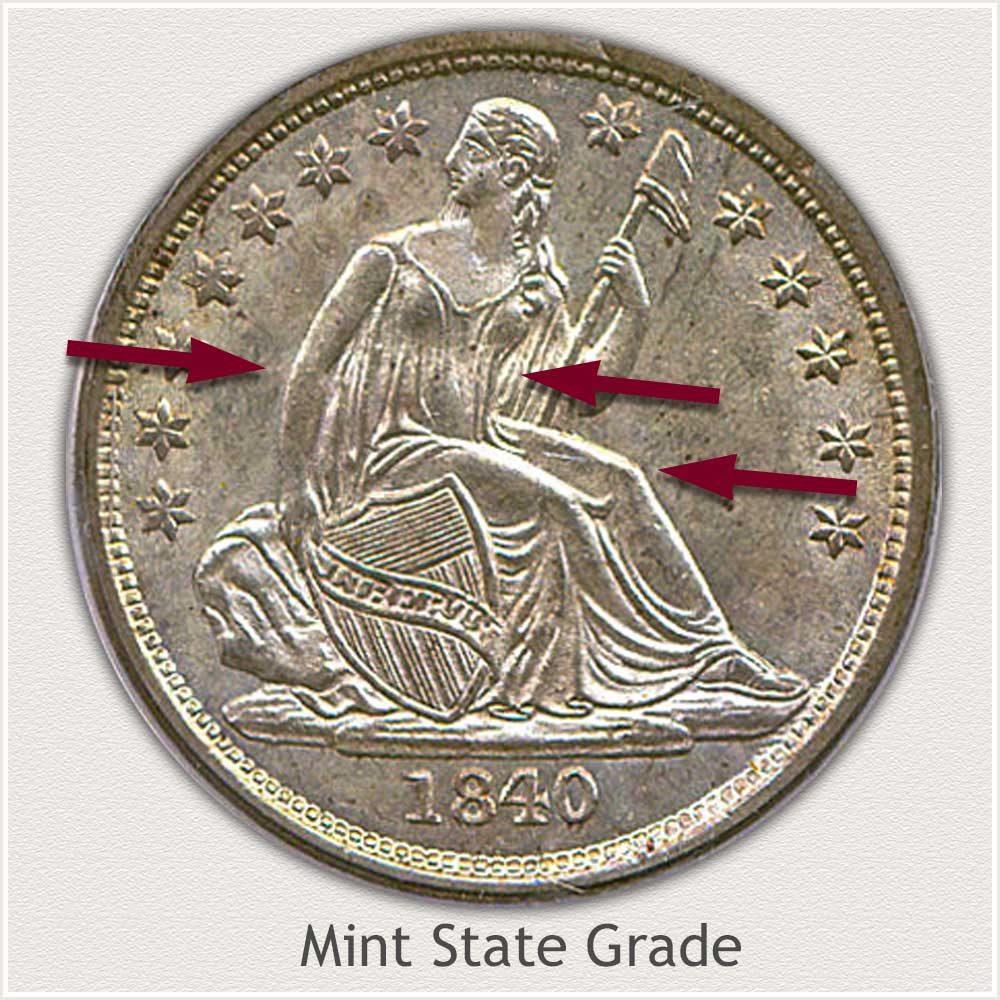
Obverse: Features Identifying Mint State Grade: Defining a true mint state grade is absence of wear on any surface of the coin. High points of design are identified and examined to confirm this highly collectible condition Seated dime.
Liberty's front, from neck line to waist remains without any smoothing to the metal. Luster - the shine - is a fine texture. Any removal of luster leaves a dullness to the surface.
Inspect both knees, looking for any signs of change in texture to the metal. A similar color and shine is found covering the knees and surrounding areas.
Liberty's left forearm is a high spot on the design. It remains without any wear from the wrist to elbow.
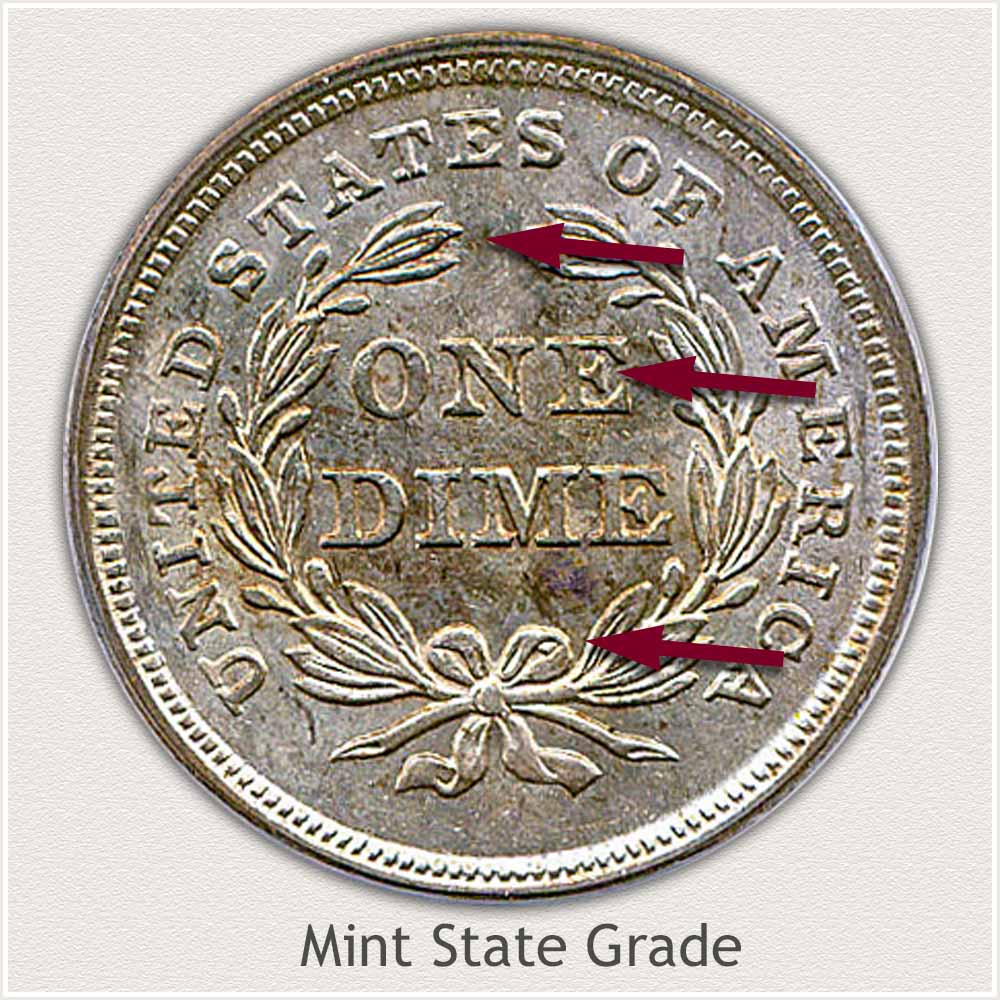
Reverse: Features Identifying Mint State Grade: Subtle changes in the "look" of the metal are indicators of wear. Confirming no wear identifies a Mint State condition coin.
High areas of the leaves are small ridges along the edges. These remain the same texture as the lower, inner parts of the leaves. Leaves and their appearance are matching leaves along the lower part of the wreath.
No flatness is seen on the bow tying the wreath. Both upper loops are nicely textured, matching inner areas. Two trialing ribbon ends are prone to wear, first along their edges. A close look shows all parts free of smoothing.
"One Dime" is very high in relief. Inspect the tops of lettering comparing to the field surface just below. A match in texture with lettering and field helps confirm no wear to the coin.
Extremely Fine Grade: "Stars Obverse" Seated Dime
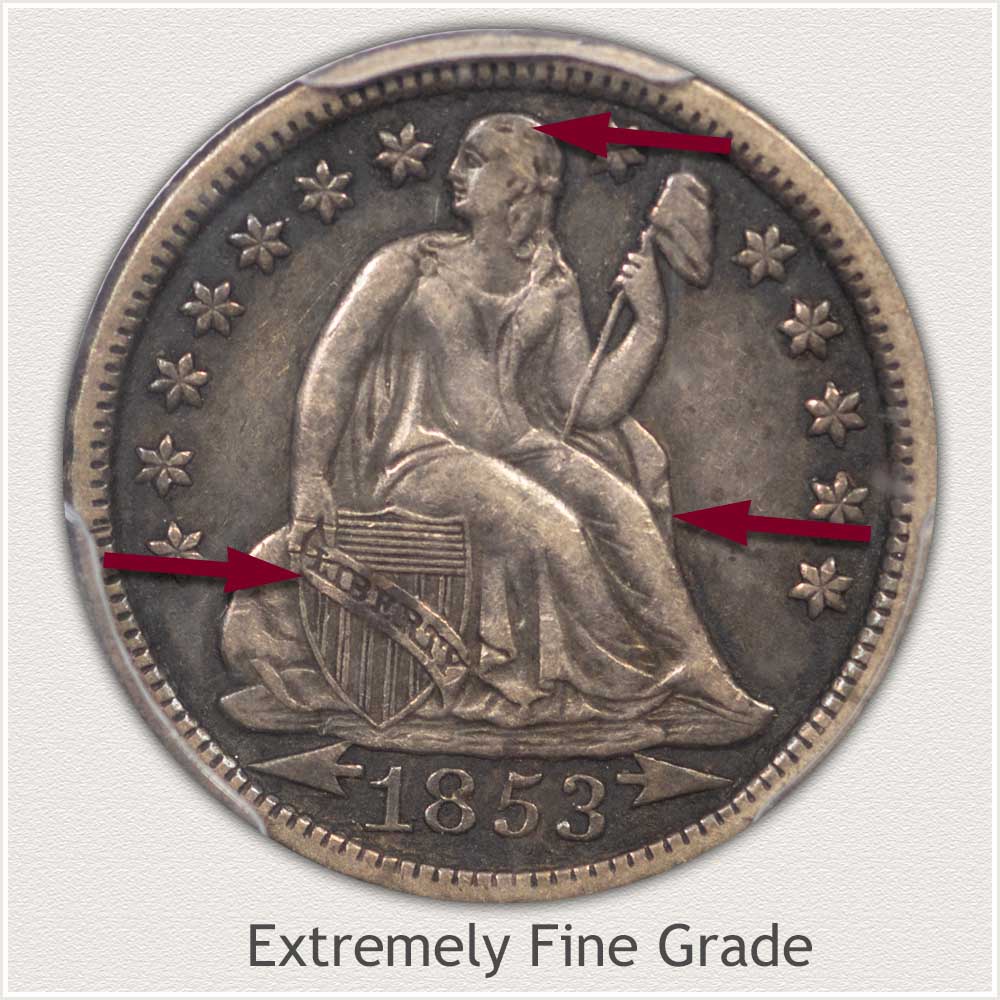
Obverse: Features Identifying Extremely Fine Grade: A light amount of wear is visible on an Extremely Fine grade Seated Liberty dime.
Wear is beginning to create a small flatness to Liberty's front knee. Her left knee is worn lightly and also upper edges of the shin.
Hair is showing wear just above her eye. A strong separation remains defining the forehead and hair.
All letters of "Liberty" are clear on the shield with the scroll boldly raised.
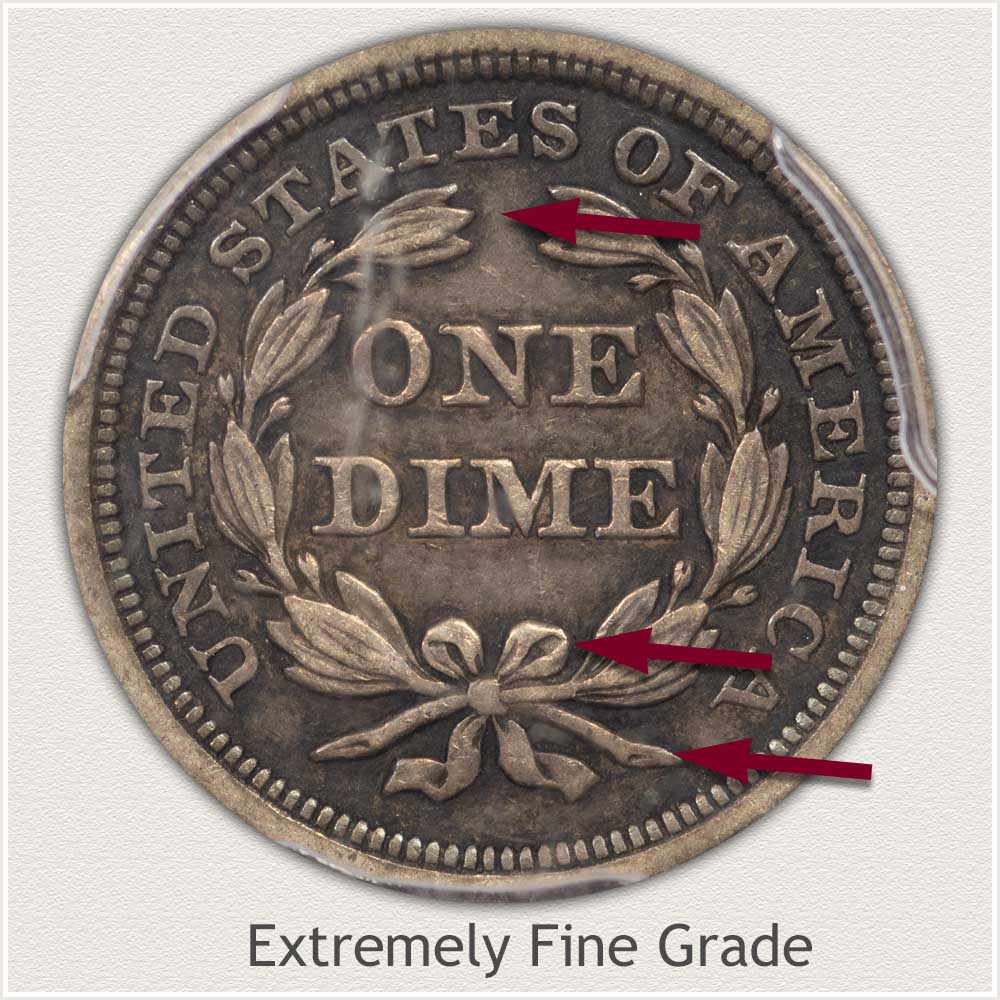
Reverse: Features Identifying Extremely Fine Grade: Wear is confined to highest design elements. Bold and crisp describes its overall look.
Olive leaves still show inner detail and wear is light on the raised edges of the leaves. One or two areas may show slightly heavier wear due to a softer strike.
Ribbon is lightly worn at upper edges of the loops. Knot in center is well defined with only slight flattening. Trailing ribbons below knot display small flat spots on upper areas.
Ends of branches either side of bow retain a small amount of contour and are not heavily flattened.
Fine Grade: "Stars Obverse" Seated Dime
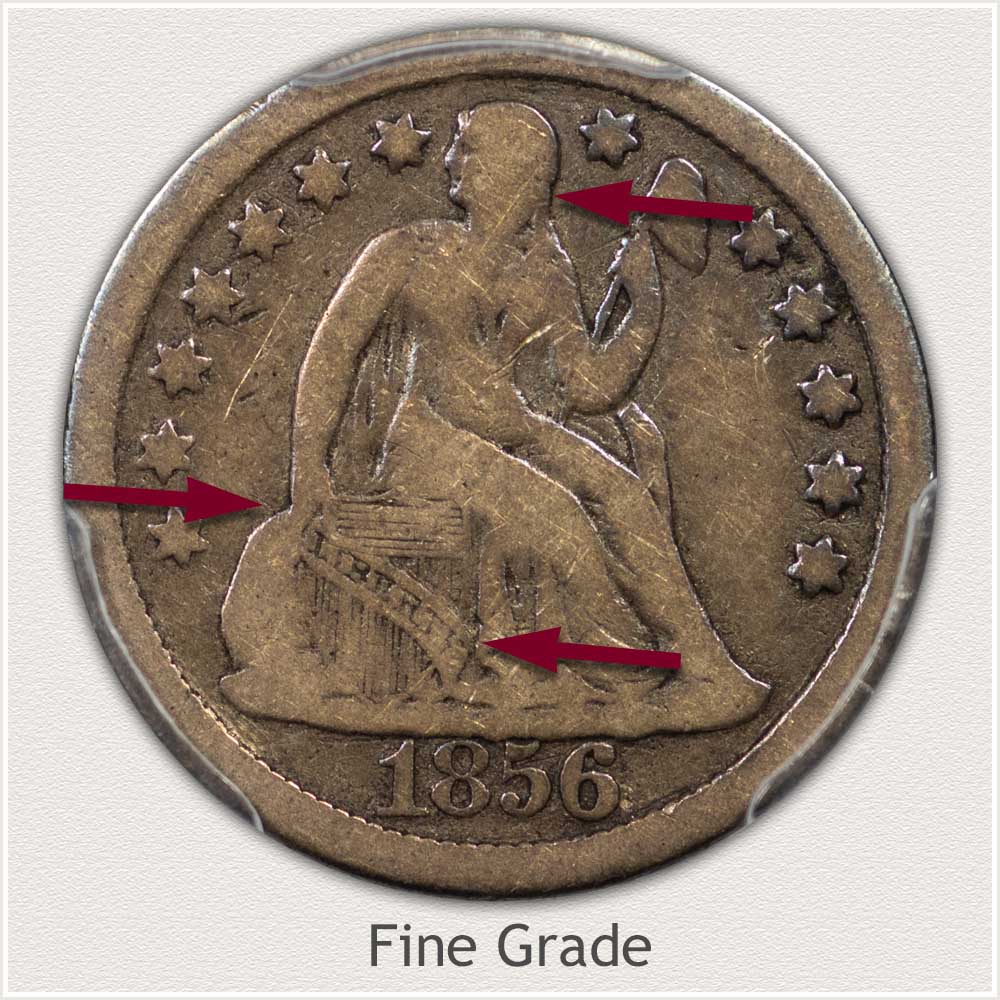
Obverse: Features Identifying the Fine Grade: Notice a fair amount of contour remains on major parts of Liberty. A lack of flatness to legs, arms, and gown is present.
A few hair details show at the back of head and a faint trial of hair to shoulder is visible.
Liberty's hand holding the shield is well defined and slightly raised.
"Liberty" is readable and clear on the scroll as it passes over the shield.
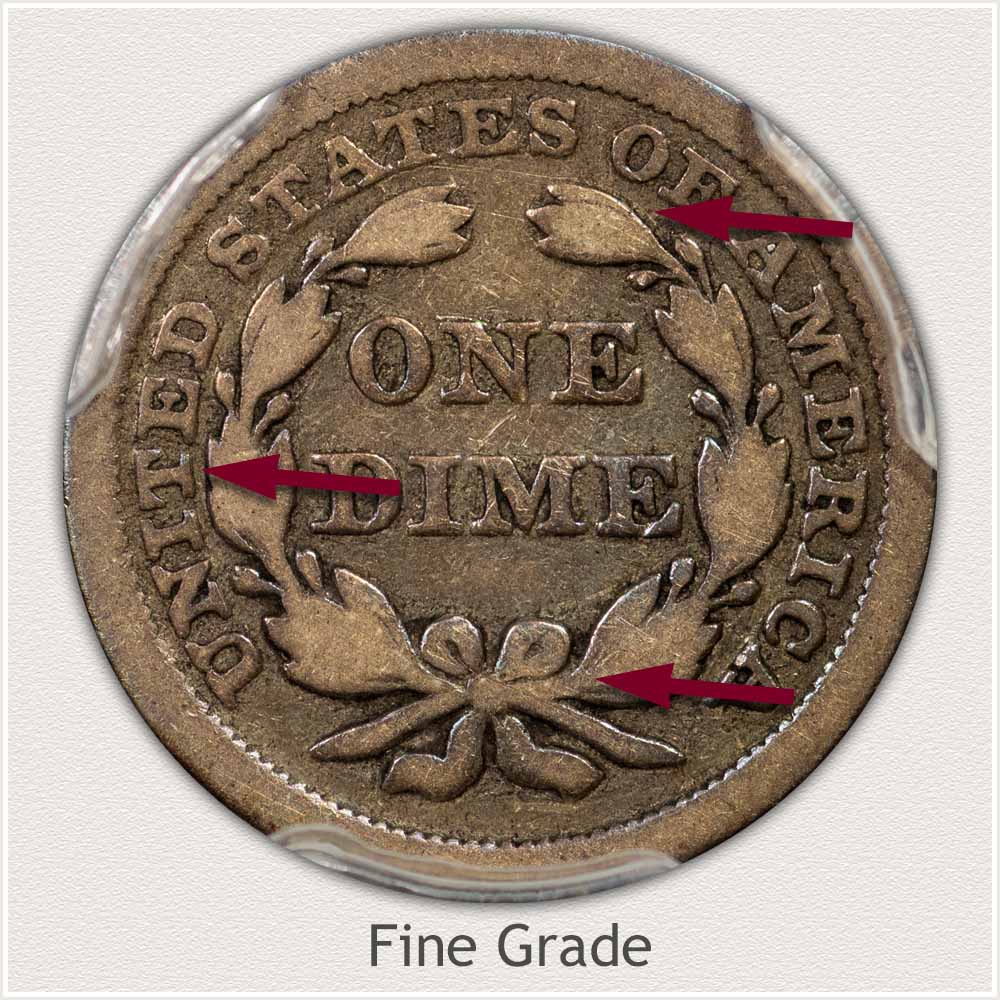
Reverse: Features Identifying the Fine Grade: A pleasing amount of design remains on a Seated Dime in Fine grade. Lettering is bold and many elements of the wreath are recognizable.
Leaves are now smooth with little central detail.
A full rim is clear and tops are fully separate of the rim.
Although flattened by wear the bow is clear and distinct. Loops, knot, and trailing ribbon are defined.
Good Grade: "Stars Obverse" Seated Dime
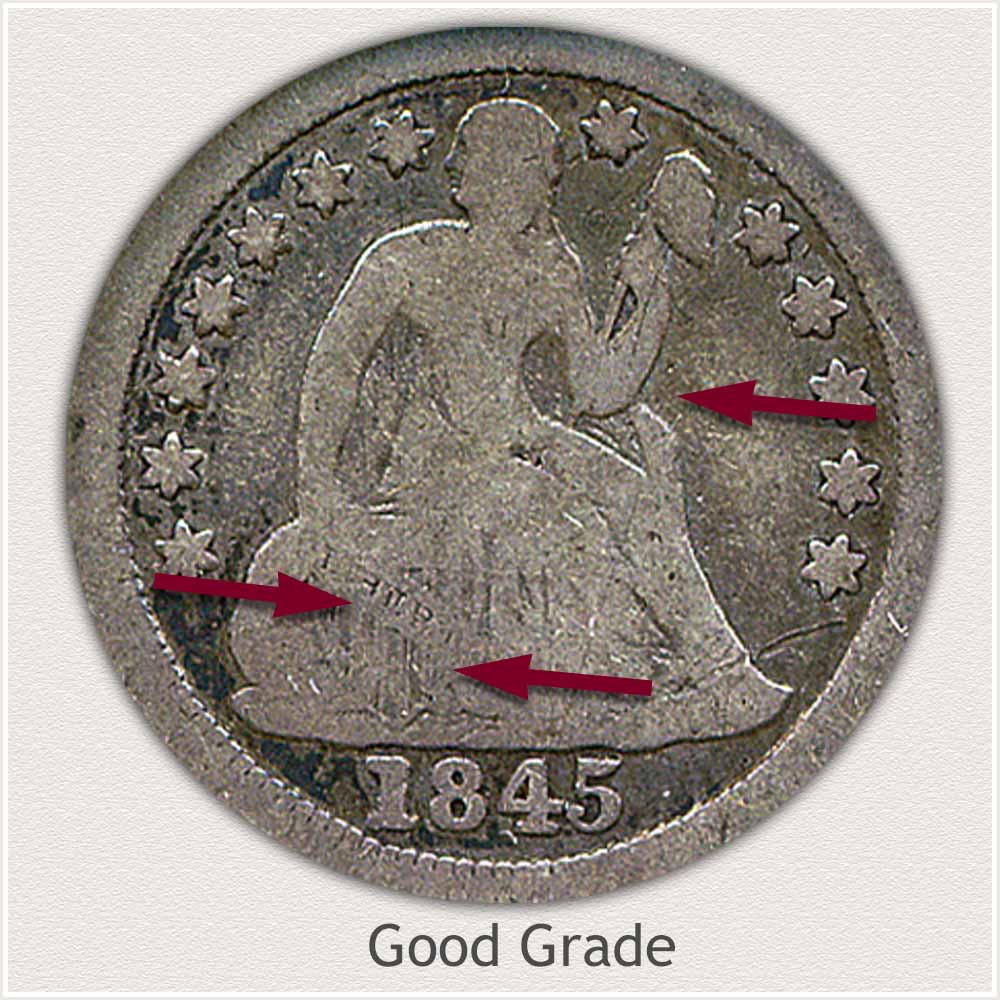
Obverse: Features Identifying the Good Grade Heavy wear has reduced most details.
Liberty's portrait is almost flat. A few details and a small contour is visible in her midsection. Knees are defined.
Some vertical lines to the shield remain. Parts of the scroll are just visible.
One are two letters of "Liberty" are faint but visible.
Stars are very flattened as well as the rim, however both are separated.
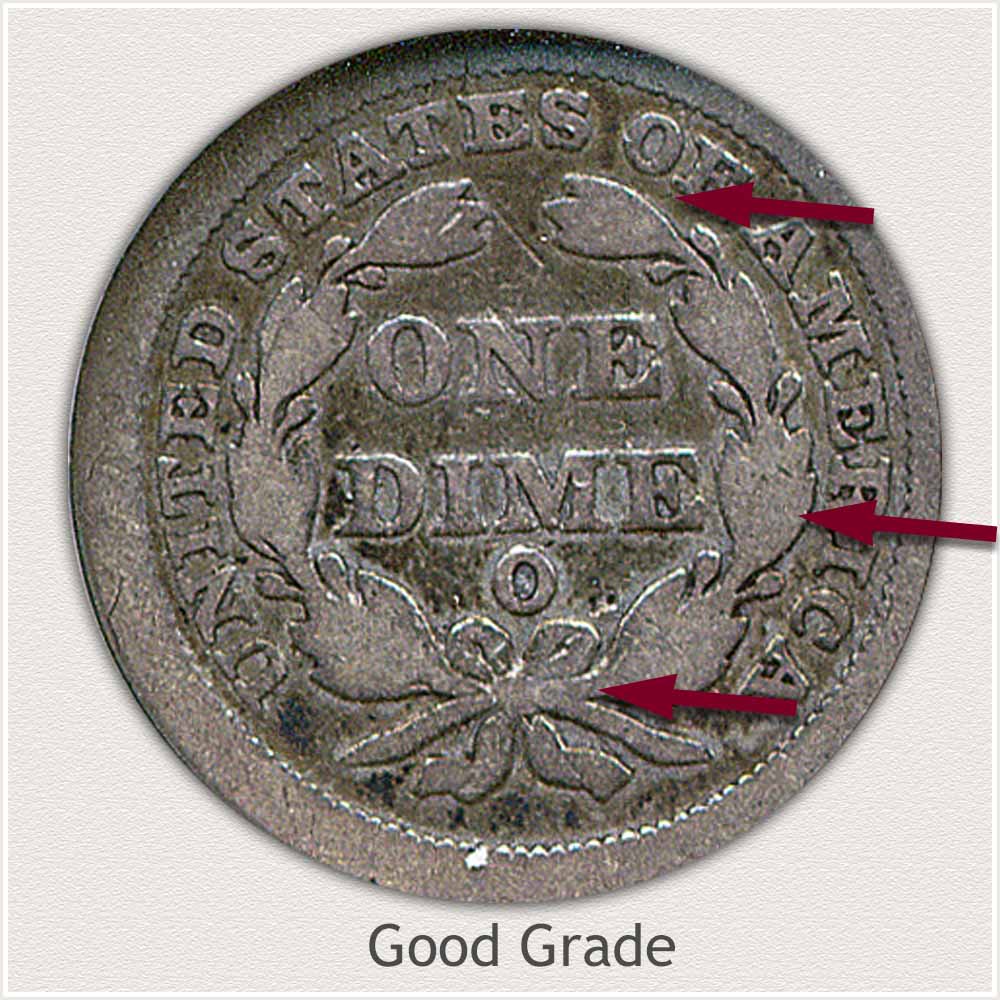
Reverse: Features Identifying the Good Grade: With heavy wear to the surface all parts of the wreath are in outline form.
Leaves are now completely smooth, no defining inner detail.
Edges to the leaves are merged into a flat group. Defining edges separating branches are also flattened.
Bow at bottom of wreath is recognizable but flat.
Legend is strong and readable.
Grading Condition of Legend Obverse Seated Dime
All the details of your coin crisp and sharp? Seated Dimes value in Extremely Fine or better condition is double or more its value in lower condition. In these upper grades they become highly desirable and trade actively.
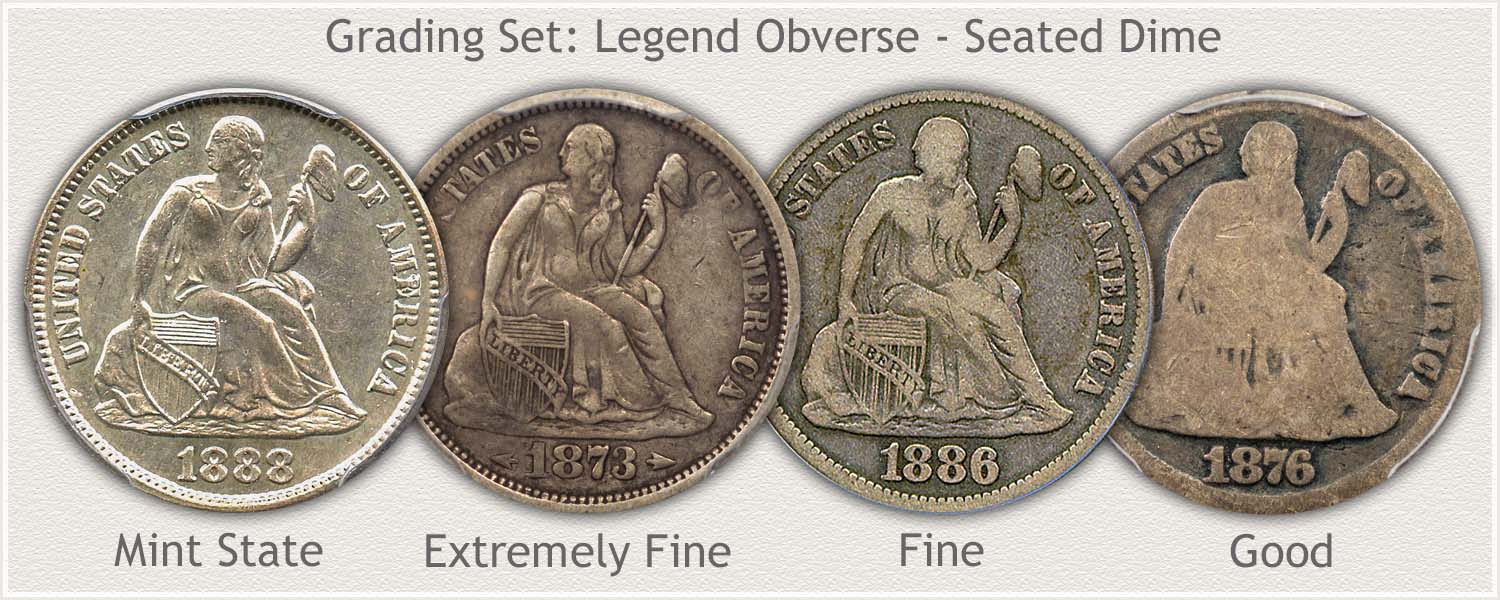
Mint State Grade: "Legend Obverse" Seated Dime
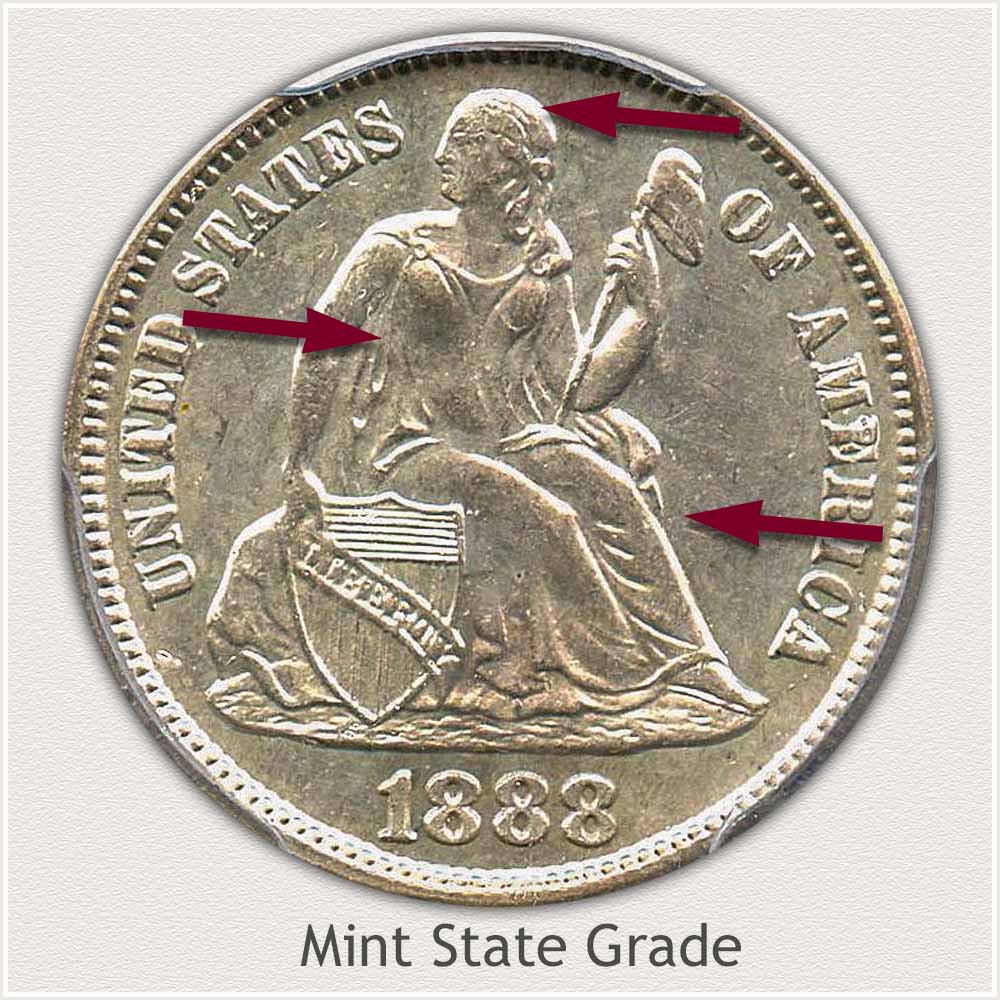
Obverse: Features Identifying Mint State Grade: All parts of the design are intact; no wear has worn or reduced any details. Mint luster remains, forming a soft texture complete over the surface.
Signs of wear are absent from the high points on the example Seated dime. Liberty's front leg is still covered with the fine texture of original luster imparted at the time of minting. No evidence of smoothing to the metal is seen.
Her gown at neck line and midsection remains without any change in texture with surrounding areas.
Inspect her hair line at the forehead. This area is prone to wear, confirm no smoothing, flattening, or change in texture. A mint state coin shows fine detail separating hairline from forehead.
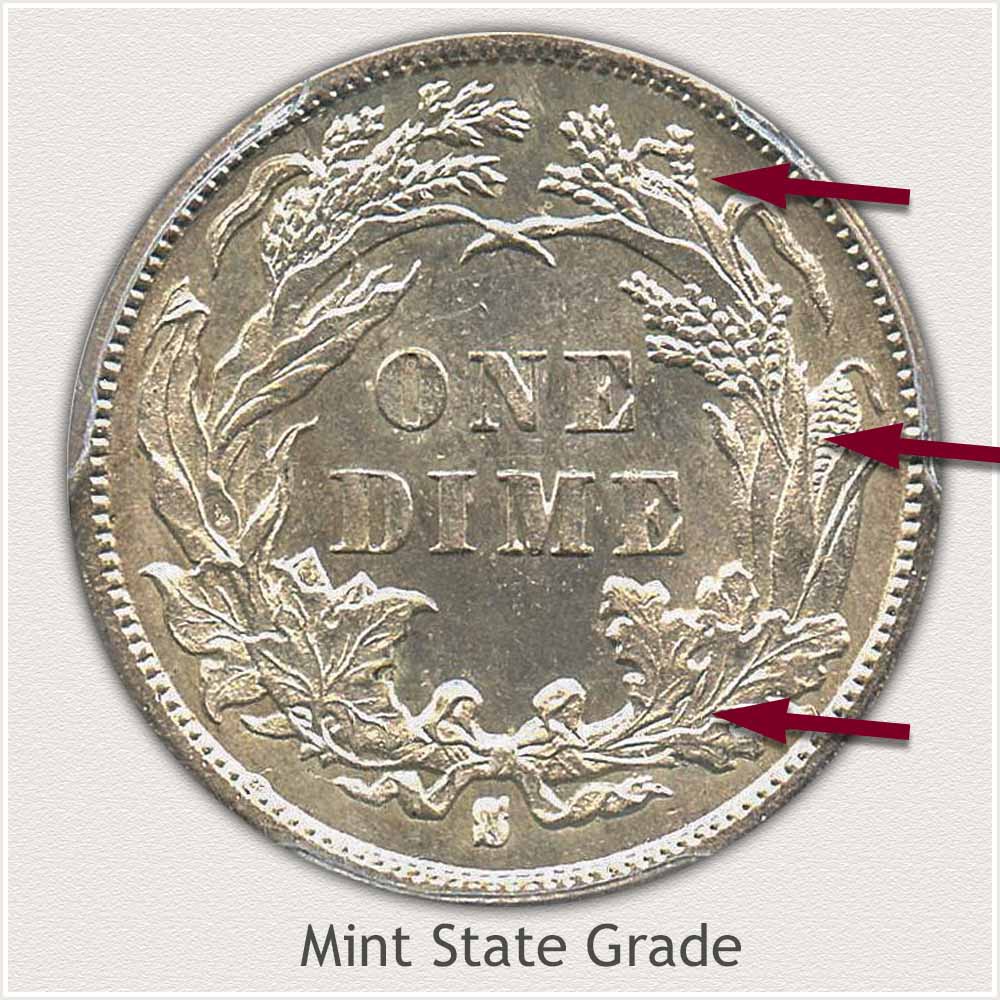
Reverse: Features Identifying Mint State Grade: Ample detail is now found with the new revised wreath design. Many high areas are delicate and quickly show evidence of wear.
Leaves close to the bow at the bottom feature fine central detail and raised edges. Look close to confirm no smoothness is present and a change in color to the metal. All surfaces should have the same "look".
Tips of leaves just either side of "One Dime" remain without any smoothness from wear.
Continue to the top of the wreath and the fine grains and kernels of corn. No small flat-smooth spots are seen on a mint state coin.
Extremely Fine Grade: "Legend Obverse" Seated Dime
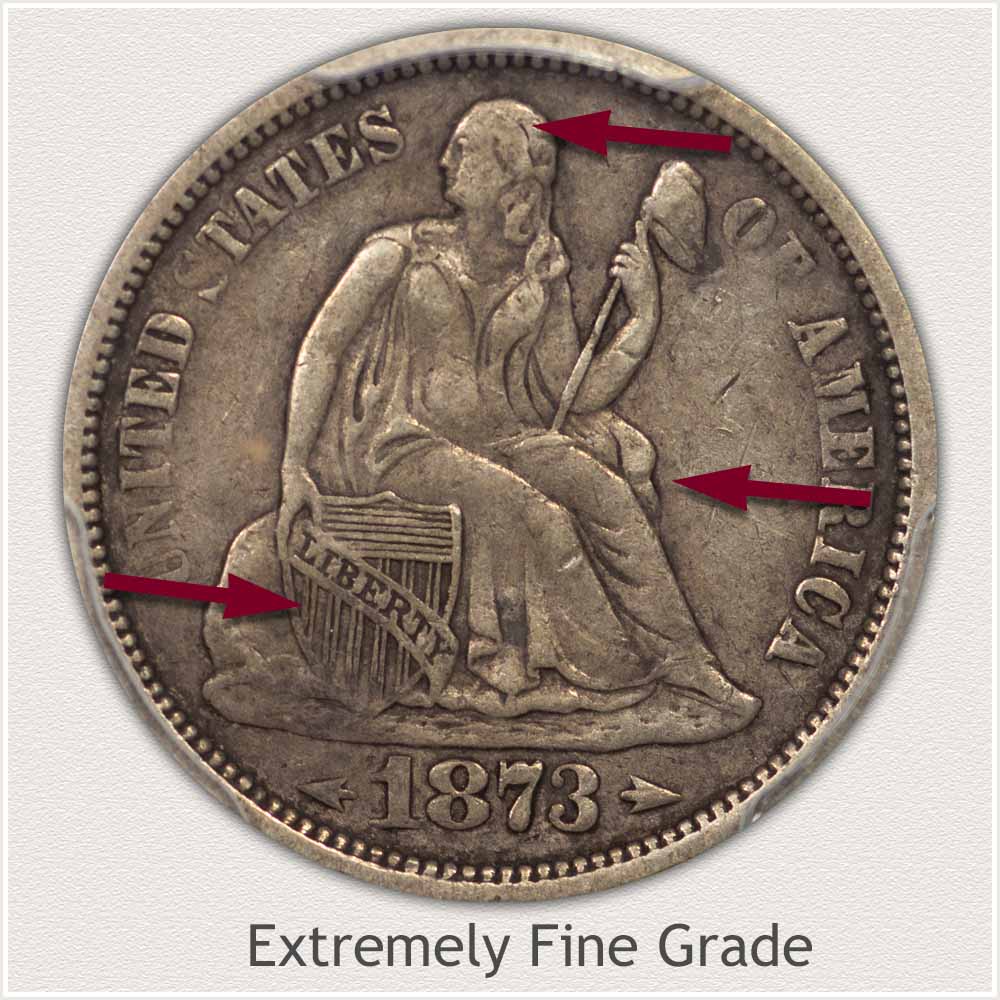
Obverse: Features Identifying Extremely Fine Grade: A moderate amount of wear has reduced some finer details causing flat areas.
Remaining visible is a separation of Liberty's hairline with her forehead. A small flatness is visible to the hair and her cheek but no merging of the two.
Liberty's knees and thighs are showing small areas of wear. A somewhat full contour remains defining her legs. Left leg appears with more wear but remains rounded.
All letters of "Liberty" across the scroll are visible. Shield remains bold and the scroll itself is raised above the vertical lines with full upper and lower edges defined.
A small flatness is noticed at the midsection of Liberty. Folds of her gown are all well detailed with just minor wear indications.
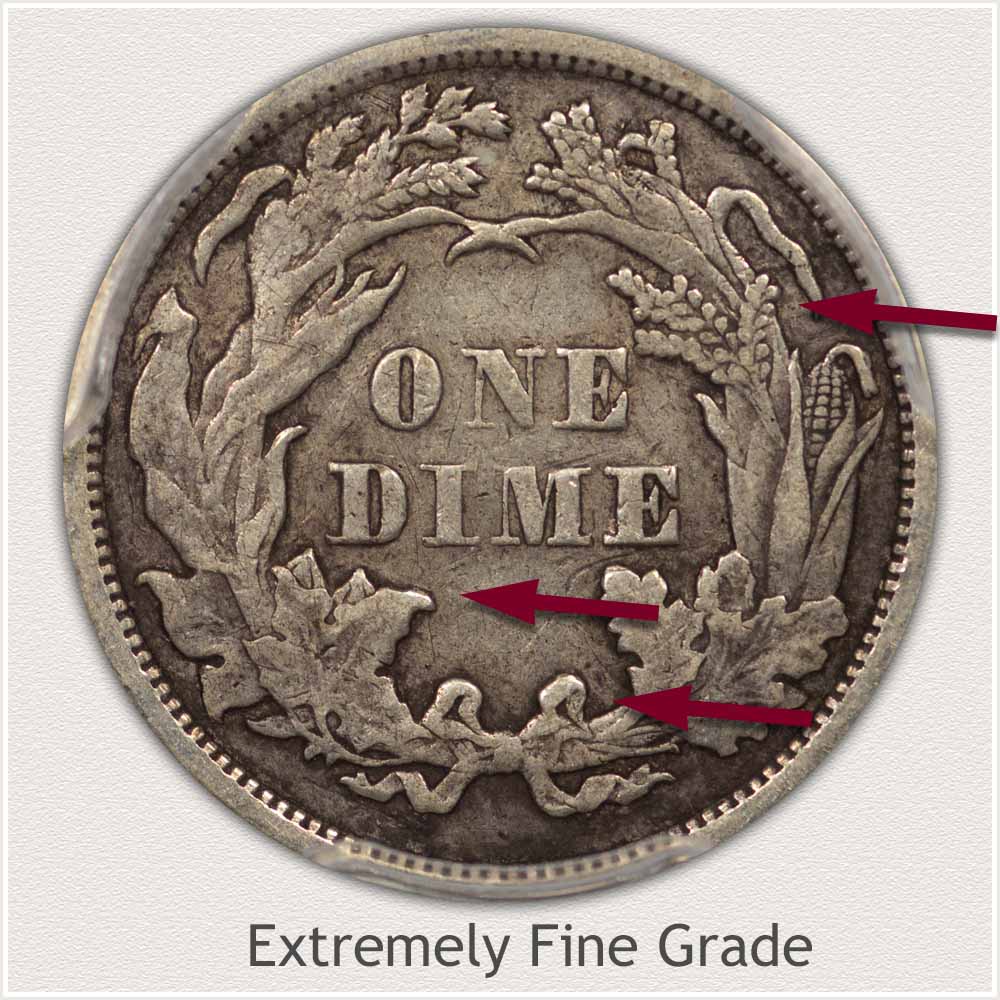
Reverse: Features Identifying Extremely Fine Grade: Giving the reverse a nice crisp look are well defined edges to most of the design within the wreath.
Oak leaves either side of the bow are just slightly worn. Inner lines to the leaves are visible and nicely raised edges remain.
The bow is well defined, loops at the top and trailing ribbon ends still show high and low areas of contour. A center knot to the bow is well detailed.
Grains of wheat and corn are flattened on just the tops. No merging is present and most remain with a rounded raised appearance.
Fine Grade: "Legend Obverse" Seated Dime
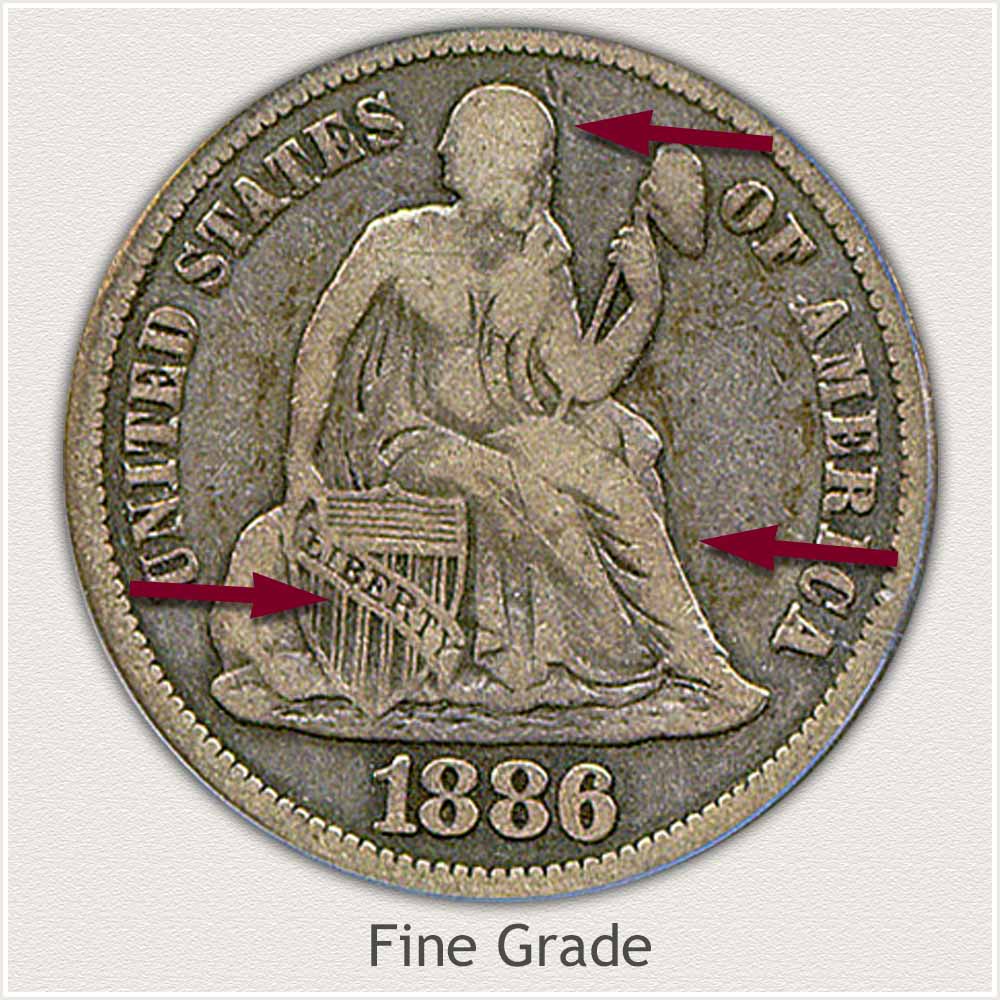
Obverse: Features Identifying the Fine Grade: Most of the major details remain on a Fine grade Seated dime. Values reflect availability, demand, and aesthetic appeal of these coins.
Liberty's head has lost most of hair and facial features. Enough contours remain defining her eye and cheek, both slightly raised from her mouth and nose.
Due to their deep impression, all letters of "Liberty" are readable. The scroll is also defined and distinct from the vertical lines of the shield.
Flatness is contentious across her thighs to ankles. Folds of the gown are strong just right of the shield.
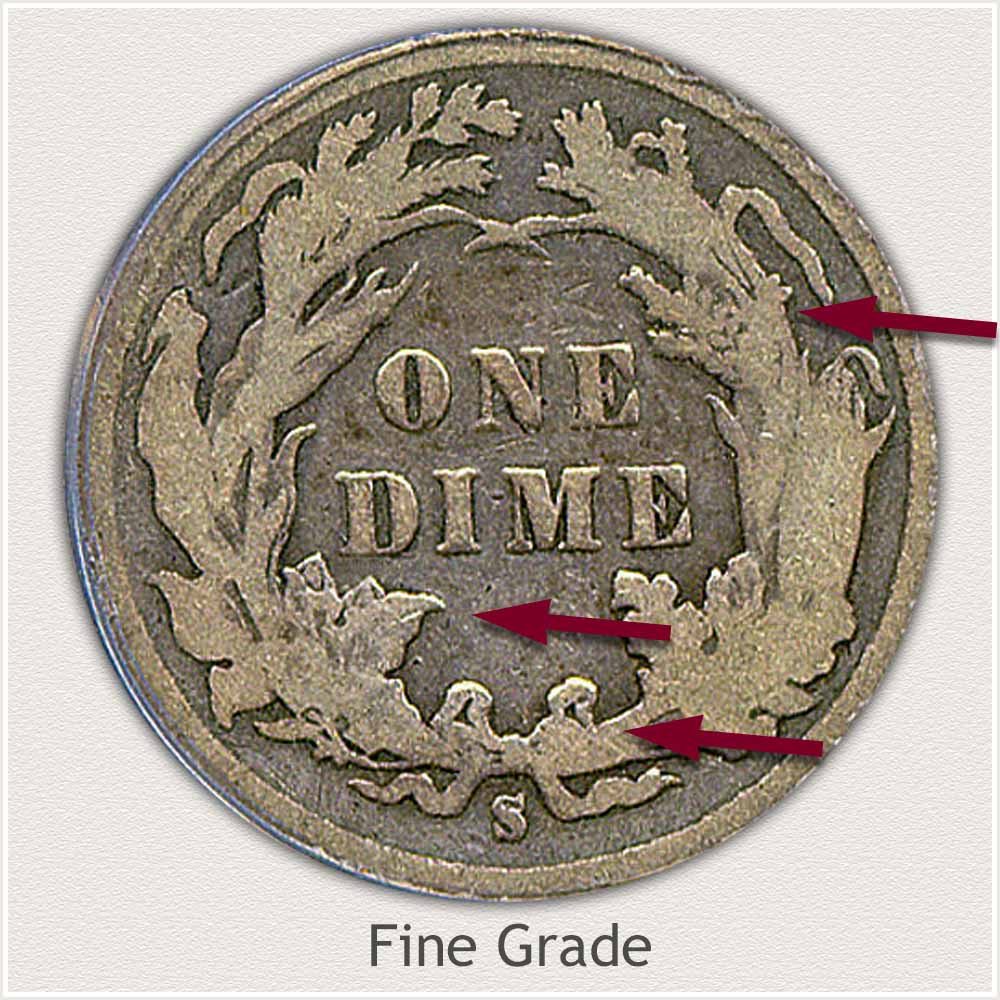
Reverse: Features Identifying the Fine Grade: Moderate wear and heavy wear have combined to reduce many parts of the design.
Leaf details are mostly worn smooth. Oak leaf to left of bow shows faint inner detail.
Most grains of wheat and corn are not merged into a flat area. Slight evidence of wheat grain is seen next to "E" of ONE.
Corn details often show on the right side.
Bow is now mostly an outline and connecting with the wreath.
Good Grade: "Legend Obverse" Seated Dime
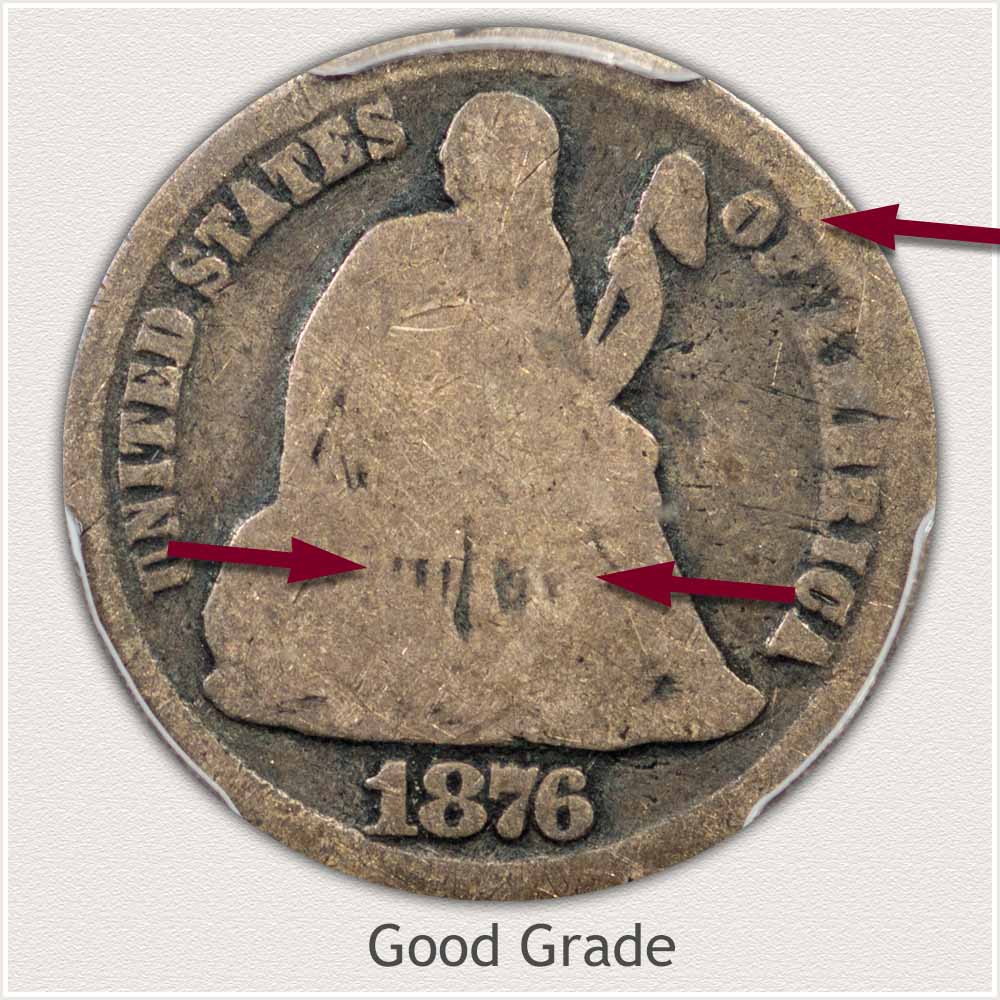
Obverse: Features Identifying the Good Grade: Good grade coins remain with enough detail to recognize a well outlined Liberty.
Many of the deeper folds in Liberty's gown are visible. From the top of the shield to her feet is a protected area and remains with a few gown lines.
The shield is represented with a partial outline. Parts of the shield are faded in areas and stronger in others.
Letters of "Liberty" across the shield are often missing or very faint.
Condition of the rim is usually weak in areas; however, tops of letters are visible.
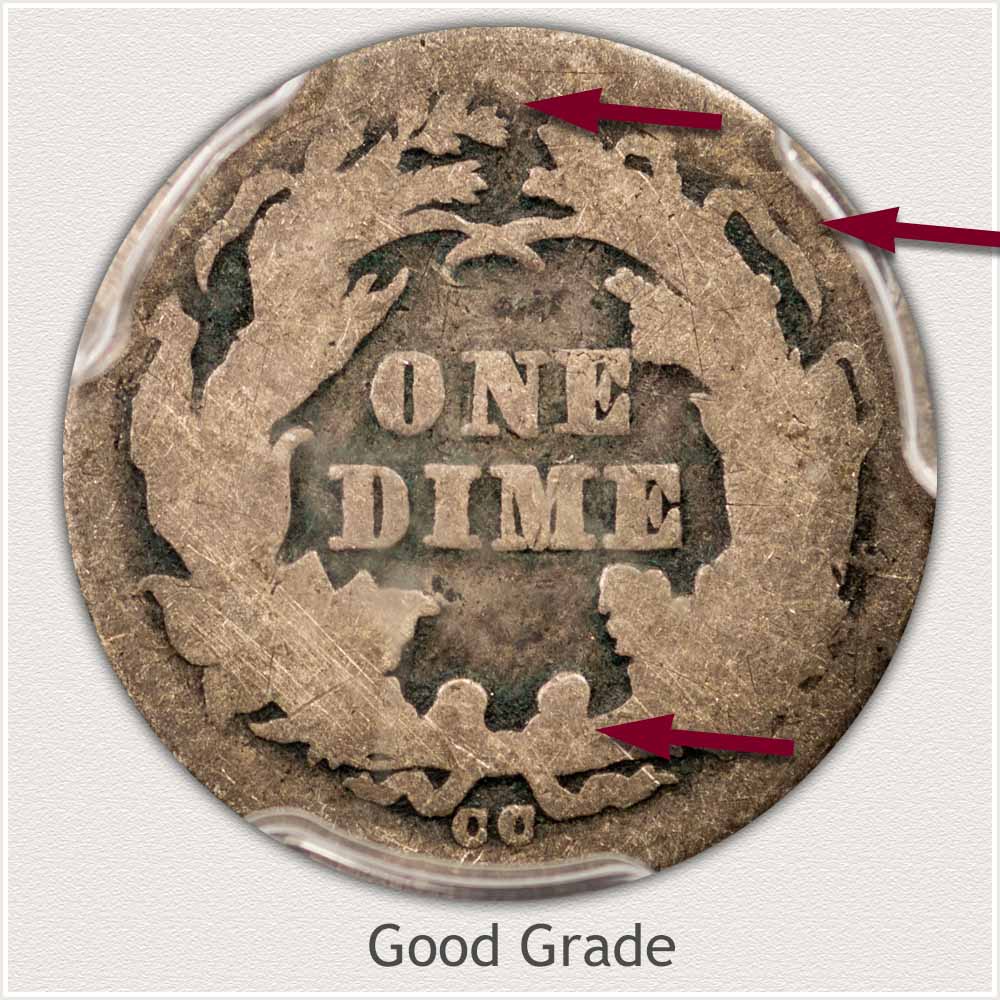
Reverse: Features Identifying the Good Grade: An outline of the wreath is complete to describe the Good condition.
Many points on the outer edges of the wreath are weak but are not faded into the field.
A complete outline of the bow is visible.
The very center of ONE DIME is weak, often faded into the field.
Rim is very weak but does not merge with the outer edges of the wreath.
Step 3: | Special Qualities Enhancing Value
A special collector quality is built into the Seated Dimes series. These dimes were a long running series and a wide variety of themes represent many ways to collect them. Date and mint runs are popular and many collectors pursue this approach. An alternative is a type collection with representatives of the major and minor varieties. With many date and mintmark combinations rare and high value; a type collection of the different varieties, when complete, is an important set.
The three major varieties No Stars | Stars | Legend Obverse is expanded with two significant sub-varieties. A few dates feature arrows added to the obverse next to the date, indicating a slight change silver weight. Both the Stars and Legend types saw arrows added on dates within the series.
Arrows at Date: 1853 to 1855
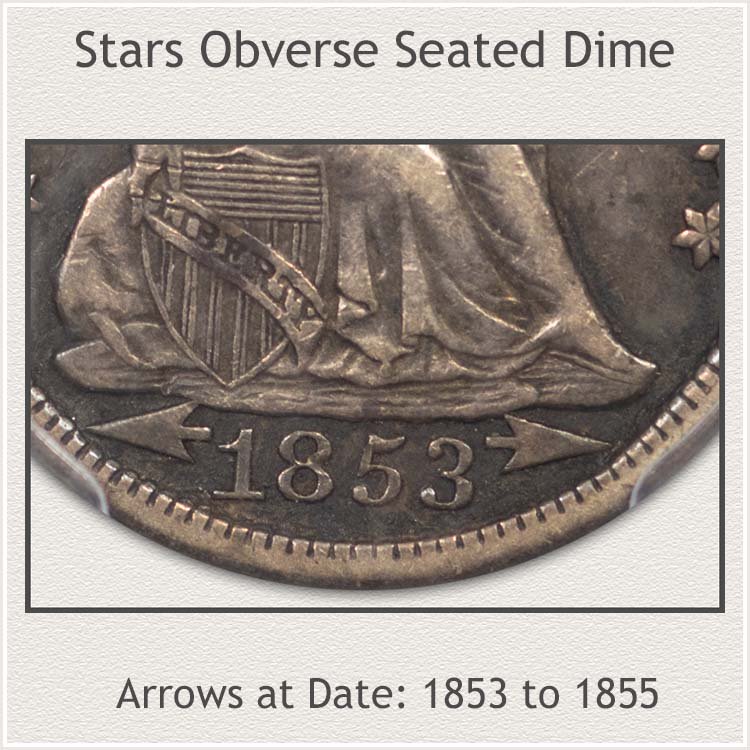
"Stars Obverse" dimes; 1853 to 1855 were minted with "Arrows" on either side of the date (a slight reduction in weight) creating a now important sub-variety Seated Dime.
Arrows at Date: 1873 to 1874
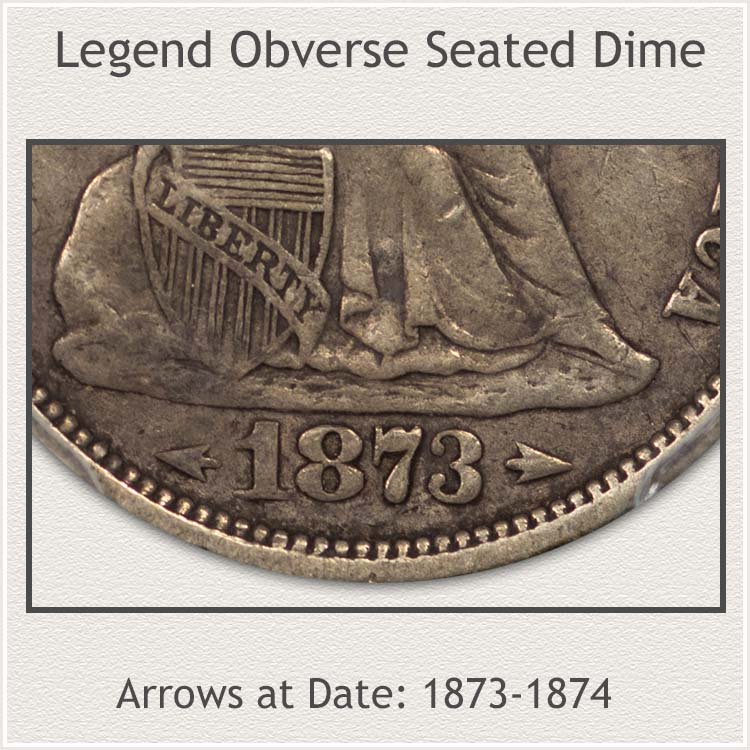
Change in weight to 2.5 grams is indicated by the "Arrows at Date" design of 1873 and 1874 ""Legend Obverse" dimes. All silver dimes, until silver was removed from US coinage in 1964, maintained the 2.5 grams total weight with a 90% silver to 10% copper alloy. As the first minting of the new alloy, it is an added small detail to any 1873 With Arrows Seated Dime.
Collectors seek these special coins creating a stable value. Both add subtle changes to the design and total quantities struck are a small percentage of the major types. Attention is paid to years 1853 and 1873; both minted with and without arrows and values are different.
References
US Mint. 1892 US Mint Annual Report.
https://nnp.wustl.edu/library/book/316
US Mint. Catalogue of Coins of the United States.
https://nnp.wustl.edu/library/book/554591
Coin Values | CoinStudy Articles
These dimes are a classic series. High quality seated dimes are always in demand by dealers and collectors. The lower grades, still attractive despite some wear, are affordable and collectible. Stay current with how much your Seated Dimes are worth.
Coin Value Guide | How to Value a Coin Collection
A step by step method combined with the coin value online guide identifies how to value a coin collection. Discover how much your box of old coins is worth.
Dime Values and Charts Covering the Many Dime Series
Discover how much your old dimes are worth. Bust, Barber Dimes, Mercury, and Roosevelt Dimes. Proceed through the steps; identifying series, variety and judging condition. Compare your coins to images and descriptions.
Selling Coins describes the different types of markets, and the type of coins to match each market. Extra effort for sure, but finding the best coin buyers yields the best results.
★ Coin Values Discovery finds Seated Dimes Value and...
All old US coin values. Index page of images to identify your coin and text links to all coin series, from Cents to Gold. Value charts, grading images and a step by step procedure uncovers how much your box of old coins is worth.
